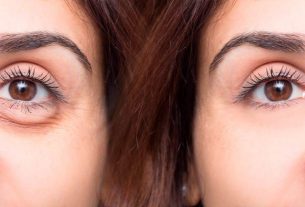Collagen is a protein that can be found in the skin, tissues, cartilage, bones and muscles and blood vessels, being responsible for giving structure, firmness and elasticity to the skin, protecting joints and building muscle mass.
Collagen, in reality, is a set of several types of proteins in the body that, when together, form specific collagen for a certain area and function in the body, there are 3 different types, collagen types 1, 2 and 3.
Collagen can be found in foods, such as meat and gelatin or food supplements in capsules or sachets or even used in the cosmetic industry in creams and moisturizers to reduce skin aging.

Type 1 collagen
Type 1 collagen is the most common and abundant in the body, being a component of the structure of connective tissues, such as skin, nails, hair, cornea, tendons, cartilage, bones, ligaments and blood vessels.
Furthermore, type 1 collagen is part of the interstitial matrix that guarantees integrity and maintains the interaction between cells.
The main functions of type 1 collagen in the body are:
- Improve skin firmness and elasticity;
- Prevent premature skin aging;
- Strengthen joints;
- Increase the resistance of cartilage;
- Assist in the treatment of osteoarthritis;
- Strengthen nails and hair;
- Help with the healing process.
Furthermore, type 1 collagen is very important in the skin healing process. However, when excessive collagen production occurs during healing, it can result in the formation of keloids. See what can cause keloids and how to avoid them.
How to take type 1 collagen
Type 1 collagen, or hydrolyzed collagen, is extracted from the bone and cartilage of animals, such as cattle and pigs, as a result of the breakdown of protein molecules into smaller particles.
This type of collagen can be taken in the form of powder or capsule supplements, with the recommended dose for adults being around 10 g of type 1 collagen per day.
Type 1 collagen supplement can be taken with meals, ideally combined with vitamin C, as this vitamin enhances the effects of collagen in the body.
It is important to remember that the dose and use of type 1 collagen should always be recommended by a dermatologist or orthopedist.
In addition to supplementation, you can also eat a diet rich in collagen, eating foods such as red and white meat or gelatin, for example. See more foods rich in collagen.
Type 1 collagen can also be found in cosmetic products, such as anti-aging creams or moisturizers. Its production can also be stimulated through the application of collagen bio-stimulators to the skin. Understand what collagen biostimulators are and their benefits.
Type 2 collagen
Type 2 collagen is a more specific type of collagen, found mainly in cartilage and bones.
The main functions of type 2 collagen are:
- Promote flexibility and support joints;
- Prevent cartilage wear;
- Reduce joint inflammation;
- Reduce cartilage injuries;
- Help in the treatment of rheumatoid arthritis or osteoarthritis.
Therefore, one of the ways to help the body replenish collagen in the cartilage is to use supplements based on type 2 collagen, which reduces inflammation and helps alleviate the symptoms of joint pain.
How to take type 2 collagen
Type 2 collagen, or undenatured collagen, is manufactured using a different process than type 1 collagen, having a different presentation and properties as well.
It is marketed as type 2 collagen, but it can be found associated with other types, such as 3 and 4.
This type of collagen is taken in a lower dose than type 1 collagen, approximately 40 mg, in a capsule, once a day, ideally on an empty stomach.
Type 3 collagen
Type 3 collagen is the second most abundant in the body, being present in soft tissues, such as muscles, blood vessel walls, uterus and intestines.
The main functions of type 3 collagen are:
- Maintain the integrity of soft tissues;
- Provide tensile strength in soft tissues;
- Facilitate platelet aggregation, contributing to the formation of blood clots.
Type 3 collagen is produced by cells as a pre-procollagen, and mutations in the gene that synthesizes type 3 collagen cause diseases such as Ehlers-Danlos syndrome.
Excessive accumulation of type 3 collagen can contribute to the development of systemic sclerosis, pulmonary or cardiac fibrosis, liver cirrhosis or renal fibrosis, for example.
How to take type 3 collagen
Type 3 collagen is normally found in association with type 1 and/or type 2 collagen, in the form of supplements such as hydrolyzed collagen.
Therefore, the recommended doses for adults of these supplements, which contain a combination of collagen, are 2.5 to 10 grams per day, and should be used under medical advice.

Sign up for our newsletter and stay up to date with exclusive news
that can transform your routine!
Warning: Undefined array key "title" in /home/storelat/public_html/wp-content/plugins/link-whisper-premium/templates/frontend/related-posts.php on line 12
Warning: Undefined array key "title_tag" in /home/storelat/public_html/wp-content/plugins/link-whisper-premium/templates/frontend/related-posts.php on line 13



